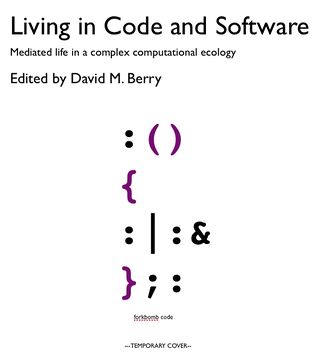Life in Code and Software/: Difference between revisions
Davidberry (talk | contribs) |
Davidberry (talk | contribs) |
||
| Line 16: | Line 16: | ||
<br> | <br> | ||
;Eric W. Weisstein : [http://mathworld.wolfram.com/TuringMachine.html What is a Turing Machine?] | ;Eric W. Weisstein : [http://mathworld.wolfram.com/TuringMachine.html What is a Turing Machine?] | ||
;Luciana Parisi & Stamatia Portanova : [http://computationalculture.net/article/soft-thought Soft Thought (in architecture and choreography)] | ;Luciana Parisi & Stamatia Portanova : [http://computationalculture.net/article/soft-thought Soft Thought (in architecture and choreography)] | ||
| Line 32: | Line 27: | ||
<youtube>E3keLeMwfHY</youtube> | <youtube>E3keLeMwfHY</youtube> | ||
''Video of a Turing Machine - Overview'' | ''Video of a Turing Machine - Overview'' | ||
;Kevin Slavin : [http://www.ted.com/talks/kevin_slavin_how_algorithms_shape_our_world.html How algorithms shape our world] | |||
<youtube>TDaFwnOiKVE</youtube> | |||
''Video shows how these complex computer programs determine: espionage tactics, stock prices, movie scripts, and architecture.'' | |||
== Code Literacy ('iteracy') == | == Code Literacy ('iteracy') == | ||
Revision as of 09:57, 16 March 2012

Mediated life in a complex computational ecology
ISBN: 978-1-60785-XXX-X
edited by David Berry
Introduction: What is code and software?
This book explores the relationship between living and code and software. It does so because these technologies increasingly make up an important part of our urban environment, and indeed stretching even to very remote areas of the world. The book introduces and explores the way in which code and software become the conditions of possibility for human living, crucially becoming a computational ecology which we inhabit. As such we need to take account of this new computational world and think about how we live today in a highly mediated code-based world. Computer code and software are not merely mechanisms, they represent an extremely rich form of media. They differ from previous instantiations of media forms in that they are highly processual. They can also have agency delegated to them, which they can then prescribe back onto other actors, but which also remain within the purview of humans to seek to understand. (more...)
Thinking Software
- Eric W. Weisstein
- What is a Turing Machine?
- Luciana Parisi & Stamatia Portanova
- Soft Thought (in architecture and choreography)
- David M. Berry
- Understanding Digital Humanities
- Alan M. Turing
- Computing machinery and intelligence
Video of a Turing Machine - Overview
- Kevin Slavin
- How algorithms shape our world
Video shows how these complex computer programs determine: espionage tactics, stock prices, movie scripts, and architecture.
Code Literacy ('iteracy')
- David M. Berry
- Iteracy: Reading, Writing and Running Code
- Louis McCallum and Davy Smith
- Show Us Your Screens
A short documentary about live coding practise by Louis McCallum and Davy Smith.
- Jeannette M. Wing
- Computational Thinking and Thinking About Computing'
Wing argues that computational thinking will be a fundamental skill used by everyone in the world. To reading, writing, and arithmetic, she adds computational thinking to everyones' analytical ability.
- Jeannette M. Wing
- Computational Thinking
- Stephan Ramsay
- On Building
- E. W. Dijkstra
- On the cruelty of really teaching computing science
Decoding Code
- David M. Berry
- A Contribution Towards a Grammar of Code
- Marino, Mark C.
- Critical Code Studies
- Lev Manovich
- Software Takes Command
- Ralph Langner
- Cracking Stuxnet, a 21st-century cyber weapon
When first discovered in 2010, the Stuxnet computer worm posed a very strange puzzle. Beyond its unusually high level of sophistication loomed a more troubling mystery: what was its purpose? Ralph Langner and team helped crack the programming code that revealed this digital warhead's final target – and its origins in international politics and cyberwarfare. This is a fascinating look inside cyber-forensics and the processes of reading code to understand how it works and what it attacks.
- A. Matrosov, E. Rodionov, D. Harley, and J. Malcho, J.
- Stuxnet Under the Microscope
- Stephen Ramsay
- Algorithms are Thoughts, Chainsaws are Tools
A short film on livecoding presented as part of the Critical Code Studies Working Group, March 2010, by Stephen Ramsay. Presents a "live reading" of a performance by composer Andrew Sorensen.
- Wendy Chun
- Critical Code Studies
Wendy Chun giving a lecture on code studies and reading source code.
- Federica Frabetti
- Critical Code Studies
Federica Frabetti giving a lecture on code studies and reading source code.
Software Ecologies
- Gilles Deleuze
- Postscript on the Societies of Control
- Robert Kitchin
- The Programmable City
- Mathew Fuller and S. Matos
- [http://nineteen.fibreculturejournal.org/fcj-135-feral-computing-from-ubiquitous-calculation-to-wild-interactions/
Feral Computing: From Ubiquitous Calculation to Wild Interactions]
- Jussi Parikka
- Media Ecologies and Imaginary Media: Transversal Expansions, Contractions, and Foldings
MacKenzie, A. (2006) “The Problem of Computer Code: Leviathan or Common Power?” Institute for Cultural Research, Lancaster University. 10 August 2006, accessed 15/03/2012, http://www.lancs.ac.uk/staff/mackenza/papers/code-leviathan.pdf
MacKenzie, A. (2008) Wirelessness as Experience of Transition, Fibreculture, 13, accessed 15/03/2012, http://thirteen.fibreculturejournal.org/fcj-085-wirelessness-as-experience-of-transition/
Gary Wolf: The quantified self: The notion of using computational device in everyday life to record everything about you.
Goetz, T. (2011) Harnessing the Power of Feedback Loops, Wired, accessed 12/09/2011, http://www.wired.com/magazine/2011/06/ff_feedbackloop/
Andersen, C. U. and Pold, S. (2011) The Scripted Spaces of Urban Ubiquitous Computing: The experience, poetics, and politics of public scripted space, Fibreculture,issue 19, accessed 15/03/2012, http://nineteen.fibreculturejournal.org/fcj-133-the-scripted-spaces-of-urban-ubiquitous-computing-the-experience-poetics-and-politics-of-public-scripted-space/
Fogg, B. J., Cuellar, G., and Danielson, D. (2003) Motivating, Influencing, and Persuading Users, In Jacko, J. and Sears A. (eds.), The human-computer interaction handbook: fundamentals, evolving technologies, and emerging applications, accessed 15/03/2012, http://bjfogg.com/hci.pdf
